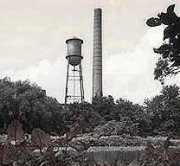Lawrence Brook Mill facts for kids
| Built | 1769 (earliest documentation) |
|---|---|
| Location | Milltown, New Jersey |
| Coordinates | 40°26′56″N 74°26′22″W / 40.44889°N 74.43944°W |
| Industry | Flour grinding, rubber manufacturing, textile manufacturing |
| Products | Flour, rubber, textiles |
| Defunct | around 1935 |
The Lawrence Brook Mill, once known as Bergen's Mill, was an important factory in Milltown, New Jersey. It started as a place to grind grain into flour. Over time, it changed and became a factory that made rubber and textiles. The mill complex included buildings like a fulling mill (for cleaning cloth), a press house, a water tower, a chimney, and homes for workers. It stopped operating around 1935.
Contents
History of the Lawrence Brook Mill
Early Days as a Gristmill (1769-1811)
The first records of a mill in Milltown date back to 1769. A man named Fulcard Van Nordstrand advertised the mill for sale, suggesting it had just been built or completed. Eight years later, Ferdinand Schuurman sold the mill. When he passed away a year later, his wife, Eleanor, and his son, Abraham, inherited it.
In 1789, Abraham sold the mill to Tunis Quick from Hunterdon County, New Jersey. Four years later, Nicholas Van Bundt bought it. He added a fulling mill, which was used to clean and thicken cloth. The mill changed hands quickly after that. John Bennett bought it a year later, then Christian Van Nortwick, who then leased it to Timothy Enixon.
Bergen's Mill and the Birth of Milltown (1811-1843)
In 1811, Jacob Bergen bought the mill and gave it his name: Bergen's Mill. He was very active, building a new fulling mill and a press house in 1812. He advertised his services, and in his advertisements, he was the first person to call the area around the mill "Milltown." Jacob Bergen managed the mill for 24 years. After he died, his family continued to run the mill.
From Mill to Rubber Factory (1843-1935)
A fire in 1843 caused the mill to stop working. After the fire, Christopher Meyer bought the property. He started the Meyer Rubber Company and turned the old mill into a factory. The buildings were repaired, but just two years later, another fire destroyed the factory and Meyer's home.
The factory was then funded by John R. Ford and renamed Ford & Co. In 1851, yet another fire destroyed the factory. But the factory was rebuilt again the next year! It was then named the Ford Rubber Company. Six years later, it became the Meyer Rubber Company once more, with Christopher Meyer returning as its president.
In 1896, the factory stopped making rubber. The India Rubber Company took over from 1897 to 1906, followed by the International Rubber Company.
Michelin's Era (1907-1930)
In 1907, the famous Michelin Tire Company took over the factory. Many of the buildings you see at the mill today were built during this time. Michelin grew quickly. In 1919, they built 53 homes in Milltown for their workers, which soon grew to 200 homes. At its busiest, Michelin employed over 2,000 people!
However, the Great Depression, a time when many people lost their jobs and businesses struggled, hit in the 1930s. Because of this, Michelin left Milltown in 1930. A few other companies, like Heidingsfield Printing Company, Algro Knitting Mills, and Alphaduct Wire, used the factory for a short time. Soon after, the factory closed its doors for good.


